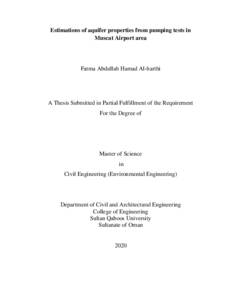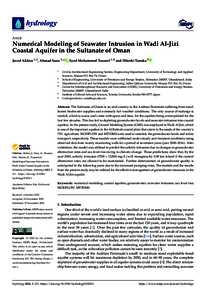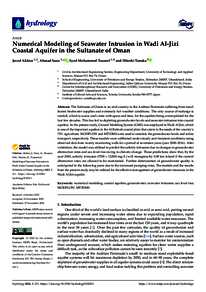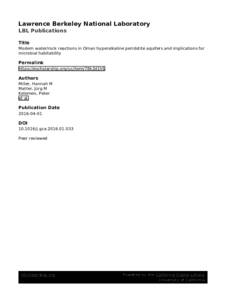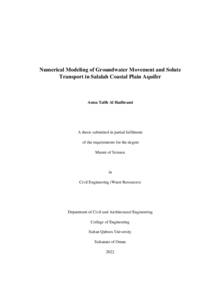Document
Estimations of aquifer properties from pumping tests in Muscat Airport area.
Publisher
Sultan Qaboos University.
Gregorian
2020
Language
English
English abstract
Rising groundwater level has become a common problem in many regions worldwide,
which happens due to natural phenomena and/or human activities. Groundwater flow
modeling is one of the important tools required for implementing adaptation and
mitigation measures for groundwater rising issue. Pumping test is commonly used for
estimating aquifer properties such as hydraulic conductivity and specific yield required
for groundwater flow simulation. When analyzing pumping test data, it is primly
important to conceptualize the surrounding boundary conditions accurately. The main
objective of this study is to analyze pumping test data obtained near an aquifer boundary
in Muscat International Airport area using an appropriate simulation method to estimate
aquifer properties. Secondly, it is expected to investigate the effect of aquifer boundary
on the drawdown curve and variation of aquifer properties.
This study used the data collected during a 24-hours long pumping test and 12-hours
long recovery test near a stream (aquifer boundary) in the Muscat International Airport
premises. Groundwater levels measured in the pumping well and in two monitoring
wells, located at 15 m and 50 m away from the pumping well, were obtained. Firstly,
pumping well data were analyzed under unconfined and transient flow conditions using
Neuman's (1975) analytical solution. AQTESOLVE program was used for matching
Neuman's theoretical curves with observed drawdown curves. Main aquifer properties
such as transmissivity, anisotropy and specific yield were found with and without the
aquifer boundary effect. Model results showed that the hydraulic conductivity and the
anisotropy of the aquifer can be differ by 13% and 21%, respectively depend on
decision to neglect the aquifer boundary.
Secondly, a MODFLOW numerical model was developed to simulate the groundwater
flow in the study area and compare observed and simulated drawdown data. Different
conditions were simulated using aquifer properties found before. Model results indicated
that the fraction of groundwater contribute from the aquifer boundary resulted to reduce
the drawdown by about 26% near to the stream. Analysis of the numerical model under
different conditions indicated that the hydraulic gradient has a significant effect on the
accuracy of the simulated drawdowns. Therefore, the assumption of initial
potentiometric surface has been horizontal, which was considered for deriving the
analytical solution, would not be valid in the presence of strong hydraulic gradient. In
such situations, it is recommended to use a numerical model.
A sensitivity analysis indicated that the drawdown increases as the pumping rate
increases. However, pumping effect becomes negligible near to the constant head stream
boundary. These results therefore suggest that the groundwater pumping as a solution to
lower the groundwater level in the airport area will not be effective with the presence of
the stream. Therefore, it is recommended not to discharge the water from chillers and
other airport activities inside the airport premises.
Member of
Resource URL
Arabic abstract
أصبح ارتفاع مستوى المياه الجوفية مشكلة شائعة في العديد من المناطق حول العالم، وهو يحدث نتيجة ظواهر طبيعية أو أنشطة إنسانية أو كلاهما. تُعدّ نمذجة تدفق المياه الجوفية واحدة من أهم الادوات الالزمة لتنفيذ تدابير التكييف والتخفيف لمشكلة ارتفاع مستوى المياه الجوفية. شاع استخدام اختبار الضخ لتقييم خصائص الطبقة الجوفية مثل التوصيل الهيدروليكي ومقدار التصريف النوعي الالزم لتحفيز تدفق المياه الجوفية. وعند تحليل اختبار الضخ، . تهدف هذه الدراسة أساسا إلى تحليل بيانات اختبار من الاهمية بمكان تصّور ظروف الحدود المحيطة تصورا دقيقً الضخ التي تم الحصول عليها بالقرب من حدّ الطبقة الجوفية في منطقة مطار مسقط الدولي باستخدام طريقة تحفيز مالئمة لتقييم خصائص الطبقة الجوفية. ثانيًا، من المتوقع دراسة أثر حد الطبقة الجوفية على منحنى السحب واختالف خصائص الطبقة الجوفية. استخدمت هذه الدراسة البيانات التي تم الحصول عليها إثر اختبار الضخ الذي استمر 42 ساعة واختبار الاسترداد الذي استمر 24 ساعة بالقرب من تدفق )حد طبقة جوفية( في مقر مطار مسقط الدولي. تم الحصول على قياس مستويات المياه الجوفية في بئر الضخ وفي بئري مراقبة يقعا على بعد 21 و 15 متر من بئر الضخ. أوًال، تم تحليل بئر الضخ حسب التدفق العابر غير المحصور باستخدام الحل التحليلي نيومان )1975 .)استخدم برنامج ُوجدت الخصائص الاساسية AQTESOLVE لتوصيل المنحنيات النظرية لنيومان بمنحنيات السحب المراقبة. للطبقة الجوفية مثل النفاذية وتباين الخواص والتصريف النوعي بأثر حد الطبقة الجوفية. أظهرت نتائج النموذج أن ًء التوصيل الهيدروليكي وتباين الخواص للطبقة الجوفية يمكن أن يختلف بنسبة 21 %و 42 على قرار إهمال % بنا حد الطبقة الجوفية. ثانًيا، تم تطوير النموذج الرقمي MODFLOW لتحفيز المياه الجوفية في منطقة الدراسة ومقارنة بيانات السحب المراقبة بالمحفزة. تم تحفيز مختلف الظروف باستخدام خصائص الطبقة الجوفية الموجودة قبل ذلك. أشارت نتائج النموذج إلى أن المقدار المأذخوذ من المياه الجوفية من حد الطبقة الجوفية أدى إلى تقليل السحب بنسبة 42 %تقريًبا بالقرب من التدفق. وأشار تحليل النموذج العددي وفق مختلف الظروف إلى أن المكّون الهيدروليكي له تأثير كبير على دقة عمليات السحب المحفزة. وبالتالي، افتراض أن سطح تساوي الكمون الاولي أفقيًا، حيث تم أخذه بعين الاعتبار من أجل الحل التحليلي ليس صحي ًحا في وجود مكون هيدروليكي قوي. وفي مثل هذه المواقف، ينصح باستخدام نموذج عددي. وأشار أحد تحاليل الحساسية أن معدل السحب يرتفع بارتفاع معدل الضخ. ومع ذلك، يصبح تأثير الضخ متضائل إلى حد كبير بالقرب من حدود التدفق الرئيسي الثابت. وتشير هذه النتائج إلى أن ضح المياه الجوفية باعتباره حالا للحد من مستوى المياه الجوفية في منطقة المطار لن يؤثر على التدفق. ولذا فإنه يوصى بتفريغ المياه من الات التبريد وغيرها من نشاطات المطار التي تُنفذ داخل مرافقه
Category
Theses and Dissertations

